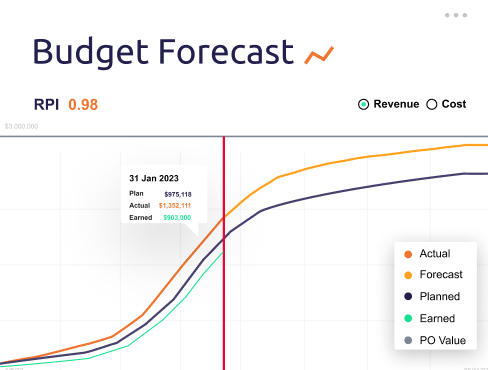Probably the most critical metric for any project manager, earned value is an excellent way to track the progress of work during a project, measured against the budgeted schedule. Now considered to be best practice in project management, calculating earned value is simplified by Proteus‘ powerful project controls monitoring and analysis.
Earned value management is built into the heart of Proteus project performance measurement: our unique baseline and forecasting functionalities help you effectively track your project progress in real-time. Rather than focusing only on the completion of listed tasks that are isolated from budget and schedule, earned value introduces a robust methodology to project management, using time, money, and resources to show the bigger picture. This game-changing approach makes project management software like Proteus indispensable to project teams and business leaders alike.
As we have previously explored in this blog, more than 70% of all projects fail to meet the scheduled timeline and budget. Worse, more than 25% of all projects fold, never making it to the planned outcome. Earned value allows a project manager to objectively track project progress and spot the early warning signals when key project control metrics do not meet the approved plan. As a simplified example, if your project is 40% complete, and your total project budget is $200,000, your earned value is $80,000 (40% of $200,000). If the actual spend is $100,000 the overspend of $20,000 indicates that there may not be enough money in the budget to complete the project (60% physical progress required for 50% of the budget).

What is earned value and why is it important?
Before we explain how Proteus helps you manage earned value across your projects, it is worth exploring more about what ‘earned value’ is and why it is important. Don’t worry, we have no intention of blowing your mind with complex formulas and PM jargon, but it is helpful to lift the bonnet a little on some of this terminology!
Earned value is the quantification of the “worth” of the work done to date.
PMI
Earned value is the percentage of how much budget has been completed, measured at a certain point in a planned schedule. It may also be referred to as the budget of work performed. It is one of the most important project management measures because it combines the two critical metrics of time and budget into one value.
Where Proteus differentiates itself from other PM tools is the ‘value’ part of earned value is cost and revenue. This allows us to calculate a project’s margin on an ongoing basis (an earned margin) which is a critical measure for the majority of supply chain companies.
Whether you are a project owner or consultancy, keeping track of your earned value can mean the difference between project success and failure. It is one of the most critical work performance information that project managers should regularly communicate to key stakeholders. If you are using your project budget at a faster rate than you have planned and therefore forecasting an overspend, visibility is key. Preparing and issuing a variation order (a process that is also fully integrated within Proteus), can increase the budget and provide coverage for the predicted overspending.
What are the benefits of measuring and analysing earned value?
The main reason metrics are tracked during the delivery of a project is to ensure everything is running as scoped. This means appropriate data needs to be forecasted at the planning stage. Earned Value Management (or EVM) is all about monitoring the project as it is happening as this is the point when work can deviate from the scope. If this is automatically calculated in real-time throughout the project, it can be a powerful tool for the project team.
The key project control metrics are:
a) The planned value – this is the budget of the work that has been scheduled.
b) The earned value – the budget of the work performed. This takes the project budget and multiplies it with the project progress.
c) The actual cost – this is what has been spent on the work performed.
d) The forecast value – this predicts the future budget based on the current actual and the current performance
When you compare the earned value with the planned value and the actual cost, you can calculate the progress and performance of the project. If you measure the schedule (the planned value) and the budget (the actual cost) separately it is much harder to assess the performance of the project and to estimate the time and cost to complete the work against the plan.
Earned value rolls up a few critical project management tasks into one methodology:
- It creates a foundation for performance measurement (baseline).
- It tracks and reports the performance of the project in real-time.
- It predicts the project end date and estimated final budget.
- It allows for variances in schedule and budget, supporting change management.
How is earned value calculated and reported?
Earned value is a simple calculation using various project data. The data used in earned value have their purpose within project management and collectively work together within an earned value management system. If the data is not accurate or up to date, the earned value calculations will be impacted. Therefore, a project team must have systems and tools in place to gather data in real time from multiple sources if necessary. This means tracking hours, budget, and deliverables often on an hourly basis. A project management tool such as Proteus will pull all this data together into one place, however, simple APIs and data integration software can be used to centralise key tracked data, for example, the spending from invoicing tools or the hours from timesheeting tools.
The basic formula for earned value is total project budget multiplied by the % of project completion. The earned value uses an S curve to display the percentage of work completed. A timeline on the x-axis shows the schedule and the y-axis tracks the budget.

How to manage earned value in Proteus
Proteus makes setting up and managing earned value easy, with many of the key data points and process steps built in as standard.
- At the tendering or feasibility stage, establish your project scope using the Proteus proposal tool.
- Build out work packages in Proteus to create your Work Breakdown Structure (WBS).
- Use contracted charge-out rates or costs to allocate a budget to each work package in your WBS. Estimate the budget for your team, equipment, software, and expenses, all accessed through the Proteus data.
- Estimate how long each work package will take to create your project schedule.
- Set a payment schedule (Planned)
- Manually update the physical progress of the project (or each work package) on a monthly basis, or alternatively integrate Proteus with a project management tool such as Primavera. Proteus will calculate the Earned Value (Earned)
- Proteus is tracking actual cost and revenue on a daily/ weekly/ monthly basis. (Actual Cost)
- Proteus calculates the Revenue, Cost and Schedule performance index (RPI, CPI, SPI)
- Proteus estimates the revenue, cost and margin at completion (Forecast)
- Use the Proteus project controls dashboards to get a view of the combined budget and schedule data.
- In Proteus, add variations to a project as new work packages. These can include hours, equipment, software, expenses, or purchases. This functionality guarantees correct approvals
About Proteus
Proteus developed by a Scottish-based tech company, Xergy Group, is an end-to-end project management solution developed for the energy and engineering consulting industries.
Proteus is industry-proven and enables consultancies to meet project demands across the full lifecycle, from proposal development to project delivery. With robust sales and project delivery modules, Proteus helps its customers win more business, increase efficiencies, manage expenditures, and improve project controls.
Critical workflows, automation, and controls are integrated into Proteus. These include opportunity evaluation, proposal building, resource planning, budget tracking and forecasting, real-time multi-level restricted dashboards, and project performance analytics.
Third-party integrations and customised solutions allow Proteus’ users, which include C-suite, project leads, and engineers, to get the exact software solution needed for their business.
We offer a free onboarding consultation service to ensure your company account is set up to your company’s needs.
How to get Proteus
Proteus operates under a software-as-a-service (SaaS) model. We offer Enterprise packages and flexible pricing solutions: contact our team to learn more.
We designed Proteus to be simple, and that means you can get up and running on Proteus without an IT team or support from a programmer. You will want to spend a bit of time configuring the admin console so that you have everything set up to suit your company structure, but it’s very intuitive and you don’t need a PhD in IT.
However, we want you to get the best out of what is a brilliantly powerful tool, so don’t hesitate to ask for our support. We have a team of product experts who are ready to help you with the configuration process, so get in touch today by filling out the form below:



